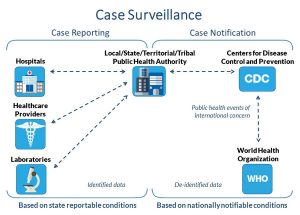COVID-19 Data Gathering and Reporting, Locally and Globally
Joshua Lambert, associate professor of Library Science at the Missouri State University Libraries, has created a new LibGuide that explains how data about COVID-19 are rapidly collected and reported, both locally and globally.
How do government entities get the numbers they use to make policy decisions related to COVID-19? What laws govern the collection of data for those numbers?
Have you been in conversation with friends and thought it would sure be helpful to have the answers to the questions above? The MSU Libraries now provides a research guide answering those questions and following is a summary.
MSU, through the Magers Health and Wellness Center, collects COVID-19 testing data and makes some of it public at the MSU Confirmed Cases Dashboard webpage. They report their data to the Greene Count Health Department. The Greene County Coronavirus Dashboard provides data for our county to the Missouri Department of Health and Senior Services (DHSS). Missouri likewise has a dashboard collecting information for all Missouri COVID-19 data.
The laws that govern disease surveillance in the United States are primarily state laws based off of national recommendations, usually from the Centers for Disease Control (CDC). Missouri Codes of State Regulations Title 19 Division 20 Chapter 20 (19 CSR 20-20) is 14 pages of regulations related to tracking and reporting of communicable diseases. This process is nothing new but COVID-19 was added to it in the last year. The rules state that, “Immediately reportable diseases or findings shall be reported to the local health authority or to the Department of Health and Senior Services immediately upon knowledge or suspicion…” COVID-19 and other diseases are in the “immediately reportable” category while over one hundred others are reported daily, within 3 days, weekly, or quarterly. A key point in the quote above is that hospitals, labs, or other clinics can report to either the local health authority or the DHSS. The county health department and DHSS then exchange data and reconcile data differences as needed. Schools, congregate living facilities, and other institutions are also required to report data.
 State governments typically collect their data and send it to the CDC on a regular basis and they are the best source of COVID-19 data. They also maintain a data tracker and weekly surveillance summary and link to downloadable data tables. National laws related to COVID-19 have changed over this year. On March 29, 2020 Vice President Mike Pence asked hospital administrators to submit spreadsheets about certain COVID-19 information daily to a FEMA email address. This was primarily during the medical equipment shortage scare time. On July 10, other guidance was given by HHS that stated information should be sent to a new system at HHS. Part of this guidance was also that hospitals were not to submit data to the CDC anymore. A modified version of that guidance was sent out as a memorandum by HHS on October 6. A further revised version of the guidance is online from December 8. With a new president coming into office, reporting rules may change again.
State governments typically collect their data and send it to the CDC on a regular basis and they are the best source of COVID-19 data. They also maintain a data tracker and weekly surveillance summary and link to downloadable data tables. National laws related to COVID-19 have changed over this year. On March 29, 2020 Vice President Mike Pence asked hospital administrators to submit spreadsheets about certain COVID-19 information daily to a FEMA email address. This was primarily during the medical equipment shortage scare time. On July 10, other guidance was given by HHS that stated information should be sent to a new system at HHS. Part of this guidance was also that hospitals were not to submit data to the CDC anymore. A modified version of that guidance was sent out as a memorandum by HHS on October 6. A further revised version of the guidance is online from December 8. With a new president coming into office, reporting rules may change again.